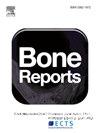Loeys-Dietz综合征所致骨骼脆性的诊断和romosozumab和denosumab的治疗
IF 2.6
Q3 ENDOCRINOLOGY & METABOLISM
引用次数: 0
摘要
Loeys-Dietz综合征(LDS)是一种常染色体显性遗传性结缔组织疾病,由TGF-β信号相关基因的致病性变异引起。LDS与低骨密度(BMD)和骨折的高风险相关。我们报告了一例43岁的绝经前妇女,骨骼脆弱,由于TGFB2基因的大量杂合缺失,被诊断为LDS 4型。在初次转诊时,她被评估为继发性骨质疏松症。虽然观察到轻微的钙代谢异常、月经不规则和缺乏运动,但它们与这种情况无关。然而,彻底的家族史和体格检查提出了马凡氏综合征和相关疾病的怀疑,随后通过基因检测证实了这一点。使用romosozumab治疗1年,腰椎骨密度从0.750 g/cm2 (z -评分- 2.1)增加到0.881 g/cm2 (z -评分- 1.0),股骨颈骨密度从0.407 g/cm2 (z -评分- 3.0)增加到0.428 g/cm2 (z -评分- 2.6),髋部总骨密度从0.525 g/cm2 (z -评分- 2.6)轻微增加到0.527 g/cm2 (z -评分- 2.4)。随后用denosumab治疗1年进一步改善腰椎骨密度至0.939 g/cm2 (z -评分,- 0.5),股骨颈骨密度至0.496 g/cm2 (z -评分,- 2.0),全髋关节骨密度至0.552 g/cm2 (z -评分,- 2.2)。据我们所知,这是首个使用romosozumab改善BMD的病例报告,随后使用denosumab治疗LDS引起的骨骼脆弱。我们的研究结果表明,这种治疗方案可能是治疗LDS患者骨骼脆性的有效选择。本文章由计算机程序翻译,如有差异,请以英文原文为准。
Diagnosis of skeletal fragility due to Loeys-Dietz syndrome and treatment with romosozumab followed by denosumab
Loeys–Dietz syndrome (LDS) is an autosomal dominant, inherited connective tissue disorder caused by a pathogenic variant in TGF-β signaling-related genes. LDS is associated with a high risk of low bone mineral density (BMD) and fractures.
We present a case report of a 43-year-old premenopausal woman with skeletal fragility who was diagnosed with LDS type 4 due to a large heterozygous deletion in the TGFB2 gene. Upon initial referral, she was evaluated for secondary osteoporosis. Although mild abnormalities in calcium metabolism, menstrual irregularities, and lack of exercise were observed, they were not associated with this condition. However, a thorough family history and physical examination raised the suspicion of Marfan syndrome and related disorders, which were subsequently confirmed using genetic testing. Treatment with romosozumab for 1 year increased the lumbar spine BMD from 0.750 g/cm2 (Z-score −2.1) to 0.881 g/cm2 (Z-score −1.0) and the femoral neck BMD from 0.407 g/cm2 (Z-score − 3.0) to 0.428 g/cm2 (Z-score − 2.6), with a slight increase in total hip BMD from 0.525 g/cm2 (Z-score −2.6) to 0.527 g/cm2 (Z-score −2.4). Subsequent therapy with denosumab for 1 year further improved the lumbar spine BMD to 0.939 g/cm2 (Z-score, −0.5), femoral neck BMD to 0.496 g/cm2 (Z-score, −2.0), and total hip BMD to 0.552 g/cm2 (Z-score, −2.2). To our knowledge, this is the first case report of an improvement in BMD with romosozumab, followed by denosumab, for skeletal fragility due to LDS. Our findings suggest that this treatment regimen may be an effective therapeutic option for the management of skeletal fragility in patients with LDS.
求助全文
通过发布文献求助,成功后即可免费获取论文全文。
去求助
来源期刊

Bone Reports
Medicine-Orthopedics and Sports Medicine
CiteScore
4.30
自引率
4.00%
发文量
444
审稿时长
57 days
期刊介绍:
Bone Reports is an interdisciplinary forum for the rapid publication of Original Research Articles and Case Reports across basic, translational and clinical aspects of bone and mineral metabolism. The journal publishes papers that are scientifically sound, with the peer review process focused principally on verifying sound methodologies, and correct data analysis and interpretation. We welcome studies either replicating or failing to replicate a previous study, and null findings. We fulfil a critical and current need to enhance research by publishing reproducibility studies and null findings.
 求助内容:
求助内容: 应助结果提醒方式:
应助结果提醒方式:


